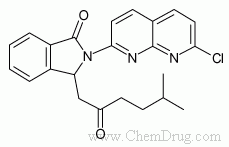
In vitro: Pagoclone has high and approximately equivalent affinity (Ki values=0.7-9.1 nM) for recombinant human GABAA receptors containing either an α1, α2, α3 or α5 subunit. Pagoclone has significant agonist activity at all four diazepam-sensitive GABAA receptor subtypes, with EC50 of 3.1-6.6 nM. In vivo: Pagoclone (3 mg/kg, p.o.) has significant anxiolytic-like activity, but at all three doses tested (0.3, 1 and 3 mg/kg p.o.) it produces a significant reduction in the total distance travelled. Pagoclone (3 mg/kg, p.o.) produces a dose-dependent increase in time spent on the open arms compared to control. Pagoclone (1, 3 or 10 mg/kg) lowers the cumulative chain-pulling response in the response sensitivity test. Plasma pagoclone concentrations are dose-dependent but not linear, with plasma concentrations of pagoclone being 0.4±0.1, 1.1±0.2 and 2.2±0.2 ng/mL, respectively. Pagoclone (0.3, 1 or 3 mg/kg) reduces locomotor activity in rats in a dose dependent manner.
| Cell Experiment | |
|---|---|
| Cell lines | |
| Preparation method | |
| Concentrations | |
| Incubation time | |
| Animal Experiment | |
|---|---|
| Animal models | Rats |
| Formulation | -- |
| Dosages | 3mg/kg |
| Administration | p.o. |
| Molecular Weight | 407.9 |
| Formula | C23H22ClN3O2 |
| CAS Number | 133737-32-3 |
| Form | Solid |
| Solubility (25°C) | 10mM in DMSO |
| Storage |
Powder -20°C 3 years ; 4°C 2 years In solvent -80°C 6 months ; -20°C 1 month |
| Species | Mouse | Rat | Rabbit | Guinea pig | Hamster | Dog |
| Weight (kg) | 0.02 | 0.15 | 1.8 | 0.4 | 0.08 | 10 |
| Body Surface Area (m2) | 0.007 | 0.025 | 0.15 | 0.05 | 0.02 | 0.5 |
| Km factor | 3 | 6 | 12 | 8 | 5 | 20 |
| Animal A (mg/kg) = Animal B (mg/kg) multiplied by | Animal B Km |
| Animal A Km |
For example, to modify the dose of Compound A used for a mouse (20 mg/kg) to a dose based on the BSA for a rat, multiply 20 mg/kg by the Km factor for a mouse and then divide by the Km factor for a rat. This calculation results in a rat equivalent dose for Compound A of 10 mg/kg.
| Related GABA Receptor Products |
|---|
| Alogabat
Alogabat (RG-7816) is a GABAA α5 receptor positive allosteric modulators (PAMs). |
| CGP7930
CGP7930 (3-(3’,5’-Di-tert-butyl-4’-hydroxy) phenyl-2, 2-dimethylpropanol) is a positive metabotropic GABAB receptor allosteric modulator. |
| 5-Aminovaleric acid
5-Aminovaleric acid is a GABA receptor antagonist. |
| L-2,4-Diaminobutyric acid dihydrochloride
L-2,4-Diaminobutyric acid dihydrochloride inhibits GABA transaminase activity, resulting in elevated GABA levels, and exhibits ex vivo antitumor activity against mouse fibrosarcoma cells. In addition, L-2,4-Diaminobutyric acid dihydrochloride can be used as an internal standard for amino acid analysis. |
| 3,4,5-Trimethoxy-trans-cinnamic acid
(E)-3,4,5-Trimethoxycinnamic acid (TMCA) is a cinnamic acid substituted by multi-methoxy groups. |


Products are for research use only. Not for human use. We do not sell to patients.
© Copyright 2010-2023 AbMole BioScience. All Rights Reserved.
